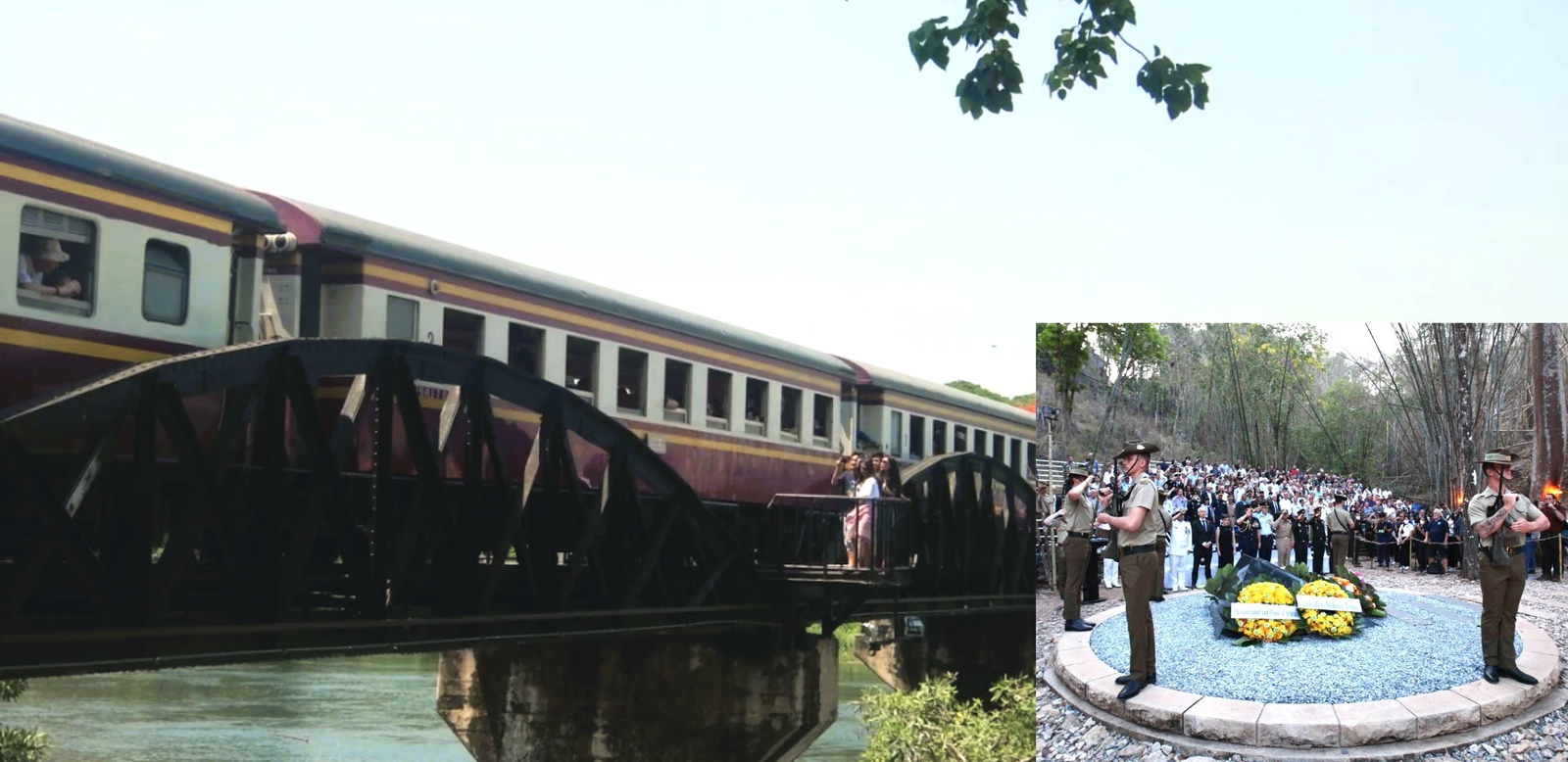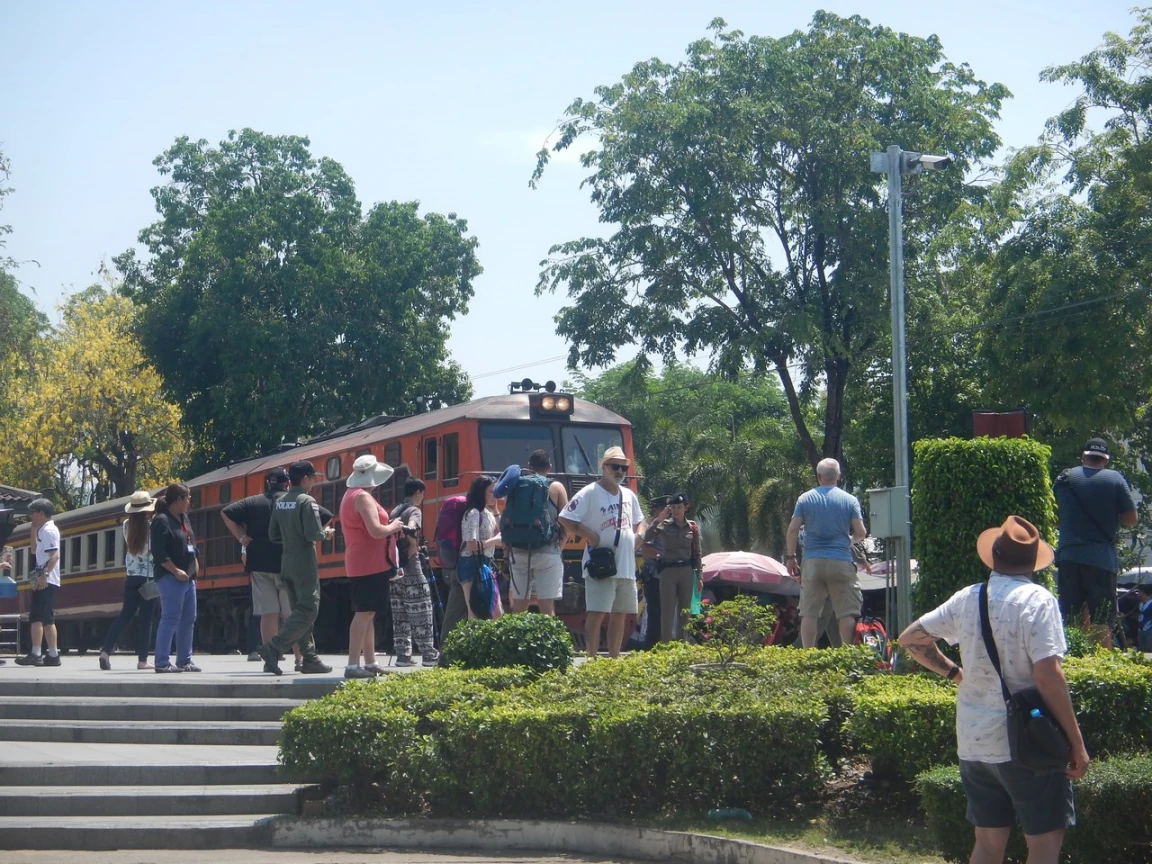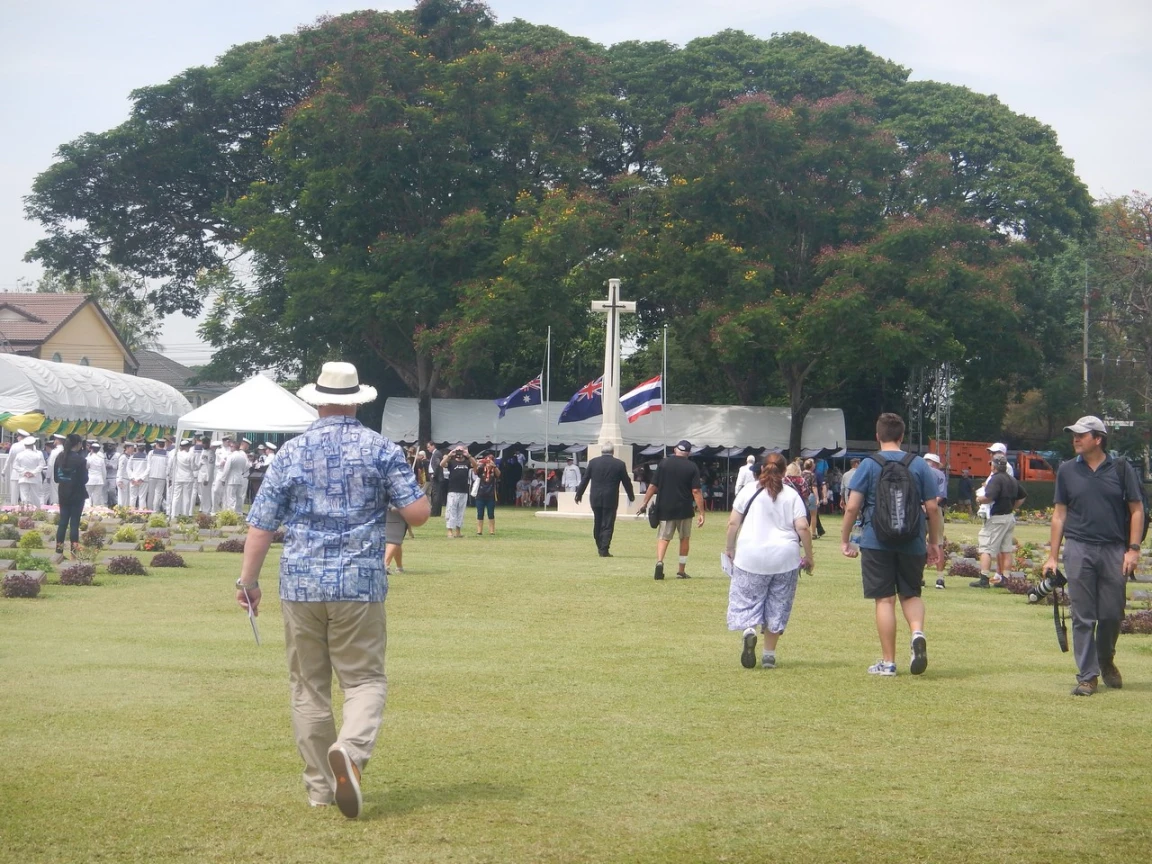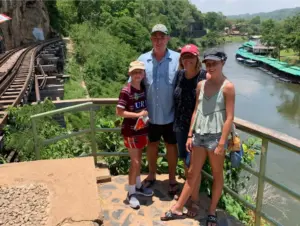
Attractions information
Kanchanaburi Province
Kanchanaburi Province which borders Myanmar (Burma) to the north-west is the third largest Thailand's of seventy six provinces.
It is located 130 km west of Bangkok and has a population of about 735,000 of which 54,000 live in Kanchanaburi town itself. This is a most picturesque part of Thailand.
Kanchanaburi town was originally established by King Rama I as a first line of defence against the Burmese, who might use the old invasion route through the Three Pagodas Pass on the Thai-Burma border.
The magnificent landscape & charming beauty of Kanchanaburi have resulted in major tourist attractions including the well-known Erawan Waterfalls, caves which were once inhabited by Neolithic man, pristine national parks, tranquil rivers, virgin forests, and reservoir.
Together, they offer an intriguing experience whether you are visiting for the first-time or returning for another visit.
Whatever your personal interest: fishing, rafting, canoeing, mountain biking, bird-watching, star-gazing, golfing, elephants, tigers, jungle trekking or even living on bamboo rafts, Kanchanaburi takes pride in offering them all.
Local residents of Kanchanaburi are engaged in agricultural activities as this is one of the most fertile provinces. Most of the locals are of Thai ancestry with notable Mon and Karen minorities.
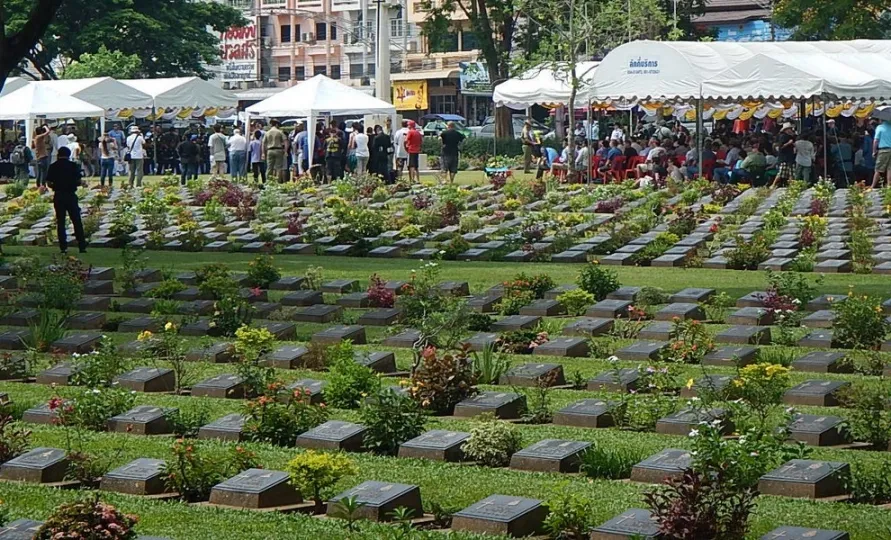
Attractions information
Don Rak War Cemetery Kanchanaburi
The Don Rak War Cemetery in Kanchanaburi is the final resting place of 6,982 Allied POWs who perished during the construction of the Death Railway during World War II.
There is another cemetery at Chungkai just outside Kanchanaburi.
Don Rak War Cemetery in Kanchanaburi is maintained in beautiful condition by the Australian Government and is a sober reminder of those who paid the supreme sacrifice so that we could live in peace.
The Kanchanaburi War Cemetery is only a short distance from the site of the former 'Kanburi', the prisoner of war base camp through which most of the prisoners passed on their way to other camps.
The graves are marked with horizontal bronze plaques set into the grass. Scarlet, purple and white bougainvillaea tumbles over the surrounding walls and flowering trees and shrubs dot the grounds. It seems a strange thing to say, but this is truly a beautiful place.
Within the entrance building to the cemetery will be found the Kanchanaburi Memorial, recording the names of eleven men of the army of undivided India buried in Muslim cemeteries in Thailand, where their graves could not be maintained.
The Don Rak War Cemetery is the location of the ANZAC Day Wreath-laying Ceremony held on 25th April each year.
Important Information
On wet days, the lawn cemetery is off-limits to the public.
If you wish to see a specific grave, please bring the number with you as there are two main cemeteries in Kanchanaburi.

Attractions information
Death Railway Wang Pho Viaduct
The Death Railway is a section of the Thai-Burma line which was built to support the Japanese occupation of Burma during World War 2. The Wang Po Viaduct is a wooden lattice structure that supports the railway line around a cliff wall with the River Kwai below and is quite spectacular.
The twice-daily train service runs from Thonburi to Nam Tok station, which is the end of the line now. It is a slow trip as the third class train stops at every little station on the way and the scenery is not so interesting.
However, once the train arrives in Kanchanaburi, everything changes. First off, the train crosses the Bridge over the River Kwai and then follows the river providing some spectacular scenery.
The highlight of course, is the train crawling around the Wang Pho viaduct and it will allow you time to reflect on the 100,000 conscripted Asian labourers and 16,000 Allied POWs who died during its construction. The two main viaducts followed the bottom of the cliff for some distance. A ledge had to be carved out of the cliff face to form a base for the bridge and embankment construction.
Near the station is the Krasae Cave, which houses a fine Buddha figure and offers a spectacular view over the River Kwai. This cave was used by the POWs as a hospital during the construction of the railway.
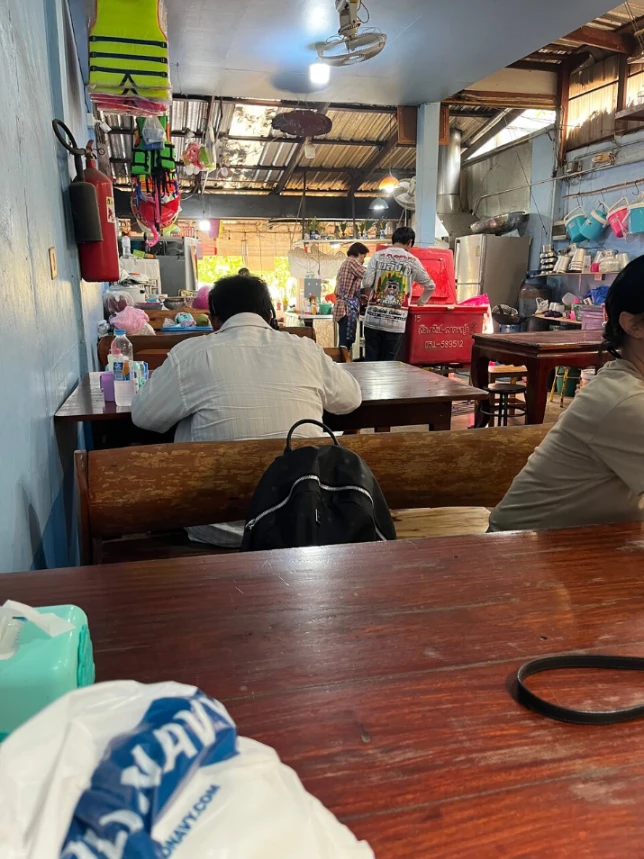
Attractions information
Lunch in a Thai Restaurant
Thai food has a range of tastes to suit all pallets so please don't make the mistake of thinking that all Thai food is spicy. Some dishes are very spicy but there are many which are not spicy at all. Rather, they are a wonderful combination of sweet and sour.
Thai dishes are normally shared by all.
Thai Cuisine is well-known for being hot and spicy and for its balance of the five fundamental flavors in the overall meal - hot (spicy), sour, sweet, salty, and bitter.
Thai food has four regional cuisines corresponding to the four main regions of the country: Northern, Northeastern (or Isan), Central, and Southern, each cuisine featuring locally grown food.
Southern curries, for example, tend to contain coconut milk and fresh turmeric, while northeastern dishes often include lime juice. The cuisine of Isan is heavily influenced by Laos.
Many popular dishes eaten in Thailand were originally Chinese dishes which were introduced to Thailand mainly by Teochew people who make up the majority of the Thai Chinese. Such dishes include Jok, Kway teow Rad Na, Khao Kha Moo and Khao Mun Gai.
Thai food is known for its enthusiastic use of fresh rather than dried herbs and spices as well as fish sauce.

Attractions information
Hellfire Pass Museum
The Hellfire Pass Museum is co-sponsored by the Thai and Australian governments to commemorate the suffering of those Prisoners of War involved in the construction of the railway connecting Thailand and Burma during World War II.
You can walk down into Konyu Cutting itself and along the old track.
Hellfire Pass or Konyu Cutting was a particularly difficult section of the line to build, not only because it was the largest rock cutting on the railway, but also because of its remoteness and the lack of proper construction tools during building.
The Australian, British, Dutch and other allied Prisoners of War were required to work 18 hours a day to complete the cutting and many died from cholera, dysentery, starvation, and exhaustion during the six weeks it took to complete.
A new walkway has recently completed down into the cutting which has made things a lot easier. You can say a quiet word of thanks to the builders on the way down. However, you'll still need decent shoes because the rail bed is stony and the rocks are hard on your feet.
From Konyu Cutting, the walking trail follows the alignment of the original Burma-Thailand railway for approximately four kilometres from Hellfire Pass to beyond Compressor Cutting.

Attractions information
Hellfire Pass Museum
The Hellfire Pass Museum is co-sponsored by the Thai and Australian governments to commemorate the suffering of those Prisoners of War involved in the construction of the railway connecting Thailand and Burma during World War II.
You can walk down into Konyu Cutting itself and along the old track.
Hellfire Pass or Konyu Cutting was a particularly difficult section of the line to build, not only because it was the largest rock cutting on the railway, but also because of its remoteness and the lack of proper construction tools during building.
The Australian, British, Dutch and other allied Prisoners of War were required to work 18 hours a day to complete the cutting and many died from cholera, dysentery, starvation, and exhaustion during the six weeks it took to complete.
A new walkway has recently completed down into the cutting which has made things a lot easier. You can say a quiet word of thanks to the builders on the way down. However, you'll still need decent shoes because the rail bed is stony and the rocks are hard on your feet.
From Konyu Cutting, the walking trail follows the alignment of the original Burma-Thailand railway for approximately four kilometres from Hellfire Pass to beyond Compressor Cutting.

Attractions information
Don Rak War Cemetery Kanchanaburi
The Don Rak War Cemetery in Kanchanaburi is the final resting place of 6,982 Allied POWs who perished during the construction of the Death Railway during World War II.
There is another cemetery at Chungkai just outside Kanchanaburi.
Don Rak War Cemetery in Kanchanaburi is maintained in beautiful condition by the Australian Government and is a sober reminder of those who paid the supreme sacrifice so that we could live in peace.
The Kanchanaburi War Cemetery is only a short distance from the site of the former 'Kanburi', the prisoner of war base camp through which most of the prisoners passed on their way to other camps.
The graves are marked with horizontal bronze plaques set into the grass. Scarlet, purple and white bougainvillaea tumbles over the surrounding walls and flowering trees and shrubs dot the grounds. It seems a strange thing to say, but this is truly a beautiful place.
Within the entrance building to the cemetery will be found the Kanchanaburi Memorial, recording the names of eleven men of the army of undivided India buried in Muslim cemeteries in Thailand, where their graves could not be maintained.
The Don Rak War Cemetery is the location of the ANZAC Day Wreath-laying Ceremony held on 25th April each year.
Important Information
On wet days, the lawn cemetery is off-limits to the public.
If you wish to see a specific grave, please bring the number with you as there are two main cemeteries in Kanchanaburi.
Anzac Day Thailand Two Day Tour (Code:2110)
Pick a day and people
THB 22,000.00
THB 22,000.00
THB 33,000.00
THB 44,000.00
THB 55,000.00
THB 66,000.00
THB 77,000.00
THB 88,000.00
THB 99,000.00
THB 110,000.00
THB 121,000.00
THB 13,200.00
This tour is not designed for cruise ship passengers. Exclusive cruise ship tours are available from Klong Toey Port and Laem Chabang Port.
ANZAC Day is commemorated on April 25 each year. A dawn parade is held at Hellfire Pass in Kanchanaburi, where the greatest number of lives were lost while constructing the Thai-Burma Railway during World War II. A ceremony at the War Cemetery honors those who perished in World War II. We have provided this tour for 25 years.
Do you want your tailor-made tour?
A tailor-made tour is the best kind of independent travel itinerary, designed and arranged just for you and your needs.
All events and activities are part of your very personal, privately guided tour.
Just ask us and we will be happy to make your tour an unforgettable experience. We have been doing this for 25 years and the quality of tailor made tours has never changed.
Why is a private tour a better choice?
With a private tour, you have the freedom to choose what you want to do and when you want to do it. There is much more room for flexibility and changes to your itinerary at every step of the way because you don't have to consider the needs of other travelers. The flexibility and freedom to make the most of your time is the reason why so many people choose to take a private tour rather than a group tour.Private Tours vs Join Tours:
Bangkok Day Tours does not run join tours. All our tours are private tours, meaning that the vehicle is for the exclusive use of your group throughout the duration of your tour. This allows you to set your own pace and to move along when you have seen enough. No waiting for the stragglers! The only exception to the ANZAC Day Tours which are run on a join basis in April each year.Tour Programme
07:00 - Pick up from strategic hotels in Bangkok
We pick up from three areas in the city and ask folks to meet at these designated hotels. Details will be provided when you book.Read More >
09:00 - Don Rak Cemetery Kanchanaburi
Don Rak War Cemetery: This cemetery contains 6,982 graves of prisoners of war. It will be the first place we visit to honor those who died in war and reflect on its destructive impact on the world. You will have time to explore the cemetery. The local guide will join us here. Read More >
11:30 - Train Ride along the 'Death Railway'
We'll board the train and ride over the Wang Pho Viaduct. The viaduct serves as a poignant reminder of the immense suffering endured by the laborers who built it, including Allied prisoners of war (POWs) and Asian laborers. As the train slowly crosses the wooden lattice structure, passengers can enjoy panoramic views of the River Kwai and the surrounding landscape, including limestone cliffs and dense jungle.Read More >
12:00 - Lunch in a Thai Restaurant
We'll stop for lunch in a local restaurant on our way up to Hellfire Pass. Don't worry if you don't like spicy food or if you have kids with you. There's plenty of variety in Thai food and you'll find something you like, no problems.Read More >
14:00 - Hellfire Pass Museum & Konyu Cutting
Hellfire Pass, also known as Konyu Cutting, is a significant historical site and museum, It is a railway cutting on the Burma Railway, infamous for its harsh conditions and high death toll, built using forced labor during World War II, visitors can explore the museum, walk the memorial trail, and learn about the history of the Burma Railway and Hellfire Pass. Take your time here. You can begin in the museum itself and then walk down into Konyu Cutting. You'll need decent walking shoes as the descent takes about 25 minutes.Read More >
18:00 - Check-in to Resort
Time to check-in to your resort.
19:00 - Dinner at the Resort
Relax and enjoy the variety of Thai cuisine in the Restaurant at the Resort.
03:15 - Day 2 Departs
03:15 - Depart for Dawn Parade Hellfire Pass
Early start this morning. We'll leave promptly at 3:15 am and will not wait for stragglers or late risers. If you are late we will be gone! Read More >
04:15 - Walk down into Konyu Cutting
Hellfire Pass is located on an army base, and the army is responsible for parking arrangements. We have to park far from the museum and take a 'songtaew' , a passenger truck, to the trailhead. From there, it's a 25-minute walk along the original railway alignment down into Konyu Cutting.
05:30 - Dawn Parade Hellfire Pass
The Dawn Parade commences at 5:30 a.m. and lasts approximately 30 minutes. The service is held at Hellfire Pass, a site of significant historical importance. During World War II, many Allied prisoners of war (POWs) and Asian laborers were forced to build the Thai-Burma Railway there. Cold water is available at various points along the cutting. It is also advisable to drink water frequently.
06:30 - Gunfire Breakfast
A Gunfire Breakfast is a traditional Anzac Day meal consisting of a hearty breakfast dish with a shot of Bundy Rum and coffee or tea. An ANZAC biscuit will be served in the car park in front of the Hellfire Pass Museum.
07:30 - Breakfast at Resort and Check-out
We'll return to the resort around 7:30 am for a hearty breakfast and you'll have time to relax before packing and checking out.
09:00 - Depart for Don Rak War Cemetery
Visitors are welcome to lay a wreath or pay their own personal tribute at Kanchanaburi Allied War Cemetery at their convenience.
12:00 - Lunch at Floating Restaurant
Lunch will be served in a local Thai restaurant.
13:00 - Depart for Bangkok
Around 1:00 pm the vans will leave for the return journey back to Bangkok.
16:00 - Arrive back at respective Hotels
You can expect to be back in Bangkok about 4:00 pm depending on the traffic.
Important Information
Hellfire Pass is an hour’s drive out of Kanchanaburi so an early start is in order. No stragglers or you’ll be left behind.Wear sensible shoes as the access is through the old railway bed and the rocks are sharp.
ANZAC Day Tours which are run on a join basis in April each year.




